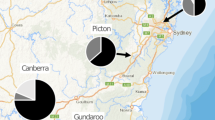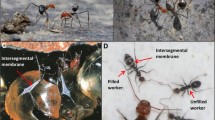Summary
Overwintered and newly co-founded nests of Exoneura bicolor exhibit different grades of sociality. Intra-colony relatedness was estimated for adults and female brood in both nest types using allozyme data and a multiallelic estimator. The higher relatedness among female brood from overwintered nests compared to newly-founded nests is consistent with the difference in sociality between these colony types (semisocial versus quasisocial). However, intra-colony relatedness among adults is higher in cofounded nests than in overwintered nests, suggesting that differences in sociality are determined by benefit/cost ratios associated with non-reproductive strategies, rather than relatedness between interactants. Rapid egg-production in newly founded nests allows eggs to be ‘stockpiled’. This reduceds the tasks available to non-reproductives in early phases of colony development and limits the payoffs available for reproductive altruism. It is suggested that the social flexibility characteristic of allodapines is a consequence of communal progressive rearing which allows many benefits from cooperative nesting to be gained without worker sterility.
Similar content being viewed by others
References
Crozier RH, Pamilo P, Crozier YC (1984) Relatedness and microgeographic genetic variation in Rhytidoponera mayri, an Australian arid-zone ant. Behav Ecol Sociobiol 15:143–150
Gadagkar R (1985) Kin recognition in social insects-A review of recent findings and a consideration of their relevance for the theory of kin selection. Proc Indian Acad Sci (Anim Sci) 94:587–621
Houston TF (1977) Nesting biology of three allodapine bees in the subgenus Exoneurella Michener. Trans R Soc S Aust 101:99–113
Jeanne RL (1986) The evolution of the organization of work in social insects. Monitore Zool Ital 20:119–133
Lester LJ, Selander RK (1981) Genetic relatedness and the social organization of Polistes colonies. Am Nat 117:147–166
Metcalf RA, Whitt GS (1977) Intra-nest relatedness in the social wasp Polistes metricus. A genetic analysis. Behav Ecol Sociobiol 2:339–351
Michener CD (1962) Biological observations on the primitively social bees of the genus “Allodapula” in the Australian region. Insectes Soc 9:355–373
Michener CD (1964) The bionomics of Exoneurella, a solitary relative of Exoneura. Pacific Insects 6:411–426
Michener CD (1965) The life cycle and social organization of bees of the genus Exoneura and their parasite Inquilina. Univ Kansas Sci Bull 46:317–358
Michener CD (1971) Biologies of African allodapine bees. Bull Amer Mus Natur Hist 145:221–301
Michener CD (1974) The social behaviour of the bees. The Belknap Press of Harvard University Press, Cambridge, Mass
Michener CD (1975) A taxonomic study of African allodapine bees. Bull Amer Mus Nat Hist 155:67–240
Michener CD (1985) From solitary to eusocial: need there be a series of intevening steps? In: Hölldobler B, Lindauer M (eds) experimental behavioural ecology and sociobiology. Gustav Fischer, Stuttgart New York
Pamilo P (1982) Genetic population structure in polygynous Formica ants. Heredity 48:95–106
Pamilo P (1984) Genetic relatedness and evolution of insect sociality. Behav Ecol Sociobiol 15:241–248
Pamilo P (1985) Genotypic correlation and regression in social groups: multiple alleles, multiple loci and subdivided populations. Genetics 107:307–320
Pamilo P, Grozier RH (1982) Measuring genetic relatedness in natural populations: methodology. J Theor Biol 21: 171–193
Pamilo P, Rosengren R (1984) Evolution of nesting strategies of ants: genetic evidence from different population types of Formica ants. Biol J Linn Soc 21:331–348
Poulik MD (1957) Starch gel electrophoresis in a discontinuous system of buffers. Nature 180:1477–1490
Rayment T (1951) Biology of the reed bees, with descriptions of three new species and two allotypes of Exoneurd. Australian Zool 11:285–313
Sakagami SF (1960) Ethological peculiarities of the primitive social bees, Allodape Lepeltier (sic) and allied genera. Insectes Soc 7:231–249
Schwarz MP (1986) Persistent multi-female nests in an Australian allodapine bee, Exoneura bicolor. Insectes Soc 33:258–277
Schwarz MP (1987) Sociality in an Australian allodapine bee Exoneura bicolor. Unpublished PhD thesis, Department of Zoology, Monash University, Clayton, Victoria, Australia
Shaw RS, Prasad P (1970) Starch gel electrophoresis of enzymes—a compilation of recipes. Biochem Genet 4:297–320
Skaife SH (1953) Subsocial bees of the genus Allodape Lep. and Serv. J Entomol Soc Southern Africa 15:3–16
Sokal RR, Rohlf FJ (1981) Biometry, 2nd ed. Freeman, San Francisco
Author information
Authors and Affiliations
Rights and permissions
About this article
Cite this article
Schwarz, M.P. Intra-colony relatedness and sociality in the allodapine bee Exoneura bicolor . Behav Ecol Sociobiol 21, 387–392 (1987). https://doi.org/10.1007/BF00299933
Received:
Accepted:
Issue Date:
DOI: https://doi.org/10.1007/BF00299933




